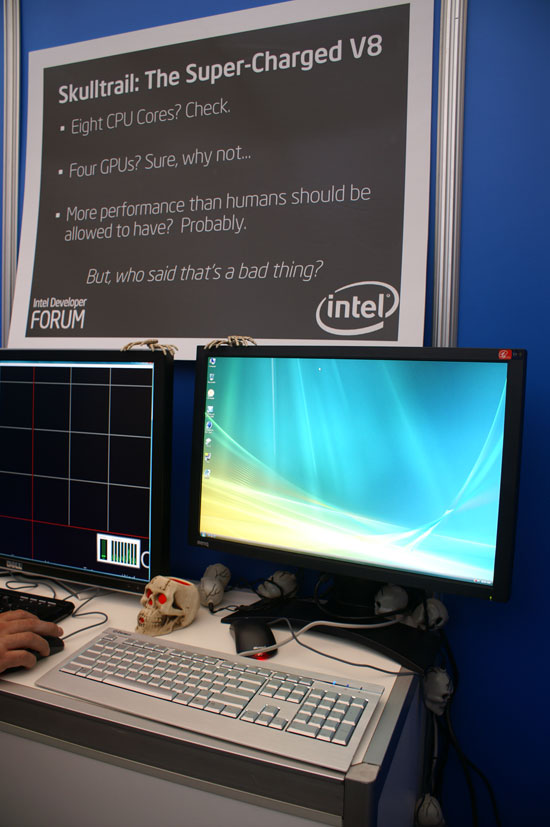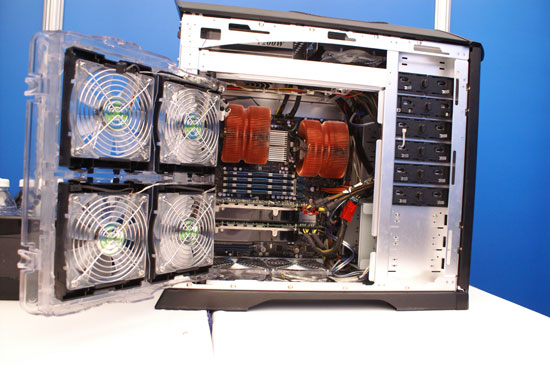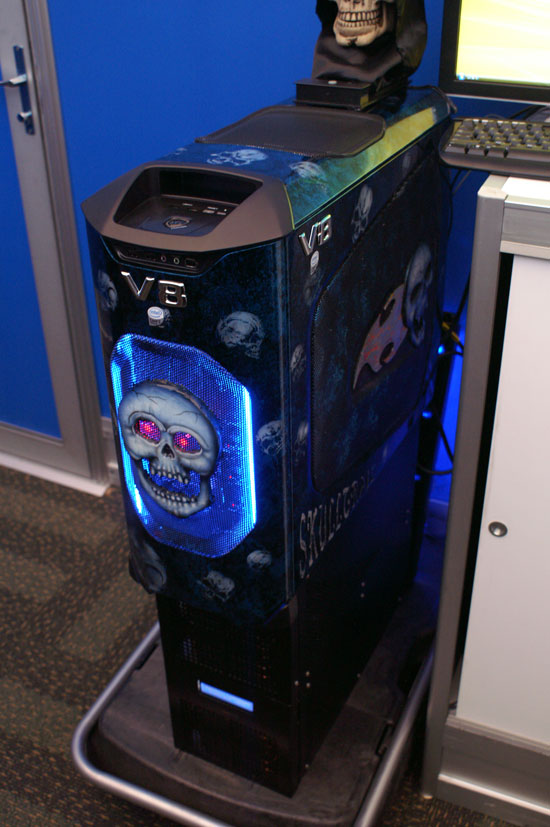Penryn and SkullTrail Benchmarked at IDF
by Anand Shimpi & Cara Hamm on September 20, 2007 3:00 PM EST- Posted in
- CPUs
Intel's 8-core SkullTrail System
Intel also had its SkullTrail system up, running, and ready to be benchmarked. SkullTrail features two LGA-771 sockets, accepting a pair of special unlocked Penryn processors that use the Xeon socket but have the same core as the desktop processors. According to Intel, with the Core 2 based processors there are slight differences in the hardware prefetchers in Xeon vs. desktop Core 2 parts and thus it is important to distinguish the SkullTrail CPUs as being Yorkfield based (desktop Penryn) and not Harpertown (server Penryn).

The SkullTrail motherboard actually supports NVIDIA's SLI, which is apparently made possible by actually using a pair of NVIDIA MCPs on the motherboard itself. This isn't an SLI licensing deal; this is Intel purchasing NVIDIA MCPs and using them on its motherboard. 2-way SLI is supported today and Intel claims eventual support for up to 4-GPU SLI, depending on whenever NVIDIA releases drivers and product.

The memory technology is still FB-DIMM unfortunately, but the speeds have been bumped from V8 to DDR2-800 now. The motherboard also offers support for a 1600MHz FSB, and the CPUs installed ran at 3.40GHz (quad-core, 12MB L2, two physical chips).

With a total of eight cores there aren't that many desktop benchmarks you can run and actually get good scaling, but Intel managed to pick some that did. The comparison system is a single-socket, quad-core Yorkfield/Penryn on an Intel X38 motherboard running at 3.0GHz/1333MHz FSB. The other key system difference is that the Yorkfield system only has a single GeForce 8800 GTX while the SkullTrail system has two, because it can support them. Intel also outfitted the Yorkfield with 2GB of memory while the SkullTrail had 4GB of memory; while the SkullTrail system should be faster regardless, it wasn't a fair fight from the get-go.

Oh look, Skulls, clever.
| Desktop System Configuration | ||
| SkullTrail System | Yorkfield System | |
| CPU | 2 x quad-core 3.4GHz 1600MHz FSB, 12MB L2 |
1 x quad-core 3.0GHz 1333MHz FSB, 12MB L2 |
| Motherboard | SkullTrail dual socket | Intel X38 |
| Graphics | 2 x GeForce 8800 GTX | 1 x GeForce 8800 GTX |
| Graphics Driver | NVIDIA pre-production driver | NVIDIA 162.22 |
| Memory | 2 x 2GB Micron DDR2-800 CL5 FB-DIMMs |
2 x 1GB Corsair CM3X1024-1333C9DHX |
| Hard Drive | Seagate Barracuda 320GB 7200.10 7200RPM |
Seagate Barracuda 320GB 7200.10 7200RPM |
| OS | Windows Vista Ultimate 32-bit | Windows Vista Ultimate 32-bit |
While we will report the 3DMark '06 numbers we ran during our time with the system, it's not entirely a CPU comparison given the dramatic difference in GPU configurations. However, the CPU tests within 3DMark do generally place the majority of the load on the CPU, while the 3D results (which we're not reporting) heavily stress the GPU(s). However, Cinebench and TMPGEnc show pure CPU-crunching 4-to-8 core CPU scaling.
| Desktop Performance Results | ||
| SkullTrail System | Penryn System | |
| 3DMark 06 V1.1.0 Pro - CPU (score, higher is better) |
6359 | 4569 |
| 3DMark 06 V1.1.0 Pro - Overall (score, higher is better) |
17006 | 11899 |
| Cinebench R10 Beta (CPU benchmark, higher is better) |
21672 | 11810 |
| TMPGEnc 4.0 Express 4.3.3.9999 Beta (seconds, lower is better) |
53 | 72 |
Cinebench R10 performance virtually doubles, while there's a 26% reduction in encoding time in TMPGEnc. If you have the applications to take advantage of it, SkullTrail will give you 8 cores today instead of waiting until sometime in 2008/2009 for octal-core Nehalem.

We're not particularly sold on SkullTrail or any of these enthusiast-class dual socket systems (e.g. QuadFX, Intel V8), the performance is there but we're not sure the usage models are. They may be perfect for workstation users who also want to game on their machines, but other than that specific market we don't see much of a need for even the most demanding enthusiasts. Stressing four cores is tough enough most of the time, making the argument for eight at the sacrifice of price, power and noise is a difficult one.

Another skull, clever-er










15 Comments
View All Comments
lebe0024 - Thursday, September 20, 2007 - link
Doesn't the Source engine now use an unlimited amount of cores? (with diminishing results, obviously)retrospooty - Thursday, September 20, 2007 - link
I hadn't heard that but its certainly possible. Either way, yes it will come eventually, maybe soon on some games, but for now the fact remains this is a high end enthusiast "gotta have it" type machine, or special purpose machine.kleinwl - Thursday, September 20, 2007 - link
As an engineering work station or graphic/video editing system this has some promiss... however as a gaming station this thing is silly (real time ray tracing aside).I would love to have this running my CFD/FEA models (assuming I can afford 8 simultanious licenses which are $10K apiece)... but running Quake 3? Seriously?
Stas - Thursday, September 20, 2007 - link
So it consumes around 800 Watt or so? And produces enough heat for you to turn your central heating system off in the winter? And costs $10K+? What a deal! Can't wait for it to become available in retail... just to watch the suckers complain about spending a ton of cash on a POS system.P.S. Performance shown is a fraction of what I would expect from that system. What was Intel thinking?
Thatguy97 - Thursday, June 18, 2015 - link
spooky scary skeletons send penyrn down your spine